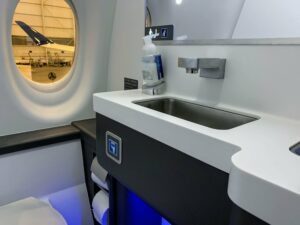Boeing confirmed Tuesday that it had secured orders for up to 121 wide-body 787 Dreamliner jets from two Saudi Arabian airlines — a major boon for the U.S. plane-maker following a sluggish month of orders.
New Saudi airline Riyadh Air, which Crown Prince Mohammed bin Salman announced over the weekend, will receive 39 of the jets, with options to order 33 more. Boeing said that state-owned Saudia, formerly Saudi Arabian Airlines, will take 39 jets with options for an additional 10.
Want more airline-specific news? Sign up for TPG’s free biweekly Aviation newsletter.
At list prices, the order is valued at roughly $35 billion, although airlines typically pay discounted prices for new aircraft.
The White House celebrated the deal, as well as Boeing’s sale of 200 aircraft to Air India earlier this year.
“Together, these deals will support over one million American jobs in the aerospace supply chain across 44 states,” White House press secretary Karine Jean-Pierre said in a statement. “This partnership is another milestone in eight decades of cooperation between Saudi Arabia and American industry.”
Riyadh Air, owned by the Saudi Arabian government’s sovereign wealth fund, will serve more than 100 global destinations by 2030, the Saudi state news agency said. Former Etihad CEO Tony Douglas will helm the carrier.
Related: Step inside Boeing’s South Carolina Dreamliner factory
The announcement comes as the latest move in a push by Saudi Arabia to diversify its economy beyond oil. As part of that campaign, the country has invested aggressively in its tourism and aerospace industries. The new carrier is expected to add $20 billion to non-oil gross domestic product growth, the Saudi Press Agency said.
It was not immediately clear how Saudia and Riyadh Air would coexist. Saudia, a SkyTeam alliance member, has typically filled less of a “transit” role than other Persian Gulf carriers, which specialize in transporting passengers across the globe via their geographically central hubs. Instead, the airline has focused more on ferrying passengers whose origin or final destination is within Saudi Arabia.
The announcement suggested that Riyadh would instead focus on connecting far-flung global destinations for transit passengers while still capturing demand to and from Saudi Arabia — emphasizing the country’s favorable location.
“The new national carrier will leverage Saudi Arabia’s strategic geographic location between the three continents of Asia, Africa and Europe, enabling Riyadh to become a gateway to the world and a global destination for transportation, trade, and tourism,” the Saudi Press Agency said.
Such a move would set up a fiercer competition for transit passengers alongside the existing Gulf airlines — Emirates, Etihad and Qatar — and Turkish Airlines. In recent years, Turkish has sought to transform itself into a major global carrier through its Istanbul hub, which is significantly closer to Europe than the Persian Gulf.
More: The 787 Dreamliner: What are the differences between an -8, -9 and -10?
The two Saudi airlines reportedly talked with Boeing and European plane-maker Airbus. But the ensuing all-Boeing order represented a blow for Airbus; both plane-makers struggle with disrupted supply chains in an effort to meet surging demand for wide-body aircraft.
Boeing is expected to resume deliveries of completed 787 aircraft in the coming days, after suspending them last month due to what it described as a data analysis issue. The Federal Aviation Administration approved the resumption of deliveries after signing off on Boeing’s fixed analyses last week.


